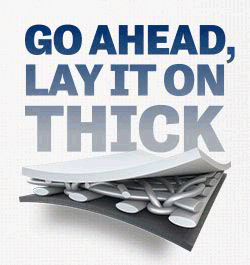Repairing what they fixed
« Back To Roofers TalkOn this job, the house was roofed about 8 yrs. ago and they did not replace the chimney flashing. It leaked, after the installation warranty had expired of course, and the home owner hired a roofing company to "fix" it.
It held up for a little while but then started leaking again. That's when she found my website on the world wide web.
I found numerous problems with the work which was done by one of my competitors which I will not name. They tore out all around the chimney, put a little piece of 30# felt down and installed a super thin piece of aluminum flashing all around the chimney ( soda can thin ) and re-used the existing galvanized counter flashing. And added some "shingle flashing" on the backside? wth?
I found a spot where the stagger from a shingle to the one above it was only ONE inch. For whatever reason, at the top where the repair ties into the main roof they cut the top inch and a half off the next to last shingle causing leaks at every spot where the shingles fit together. Then they installed the last shingle and drove nails straight down into the roof and just put a little dab of tar on it.




Tinner666: OW, sorry if I sounded like I was finding fault. I merely wanted to show something as a counterpart illustrating the different ways to do the same thing.
That makes two of us then! Actually 6 of us so far! ;)
OW, sorry if I sounded like I was finding fault. I merely wanted to show something as a counterpart illustrating the different ways to do the same thing.
"This is true. There is almost nothing that gripes me more than some ruling which outlaws individual preferences among alternatives that work. Even when it is made law, personal preference will never be anything other than personal preference. If something has been done and has been shown to work, it should never be excluded from accepted practice and if it is, any parties participating in the exclusion should be barred from future involvement in policy-making decisions."
Egg, when I went to my last certification class for EPDM, I had a counterpoint for many things the instructor said needed to be done. After we went over procedures and points, he turned to the class and said that they needed people that could think and act outside the instruction manual. He said that there was a rule for everything and an exception to every one of them and a roofer needed to be able to think, realize the reality in front of him and be able to act on it. He then brought up over points and turned each question over to me to explain to the class and every time a student asked one, he deferred to me. There were many I couldn't answer though!
Twill prefers a cricket.
GSD would have squared the storm guard off due to ice damming issues.
Tinner believes storm guard to be unneeded.
Woody would stick the storm guard to bare wood.
==========================================================
I don't like building crickets and don't bother with them unless the area of the roof where the chimney is located has a leaf build up issue. Sometimes I just leave the existing crickets in place, storm guard and flash. Other times I tear them off. It won't leak either way.
No ice damming issues down here in my little world. I could have cut that top piece of storm guard straight across to be even with the side pieces ( square ) but even the side pieces are about a foot higher than water could ever get even if the flashing failed, which it won't.
I can't see me ever using storm guard on a slate job with spaced decking and the like. And I agree that it's not needed. But using it on shingle work is going above and beyond what is necessary and the clients really appreciate that. They like the concept of it and it pleases them. Very often when they see the job progress pics with the storm guard installed, they show their appreciation with excitement, exclaiming wow that's awesome or something similar.
The issue of sticking storm guard only to bare wood is a regional one. That's what roofers in areas with ice damming problems were taught. Here in the extreme south however, it's fine to apply it to felt but the felt must be smooth and clean. I sometimes put nails in the top part of it and when the shingles are installed many more nails end up through it and it stays in place just fine.
This particular job could have been done any one of the ways any of us suggest and would have been a major improvement over what these last monkeys did. I think my 10 yr. old daughter could have done this one better than them. :laugh:
I can't believe no one noticed that I used step flashing on the sides of this one. All the other job pics I've shown on the RCS were of 4x4 hemmed wall flashing. And again either way works fine if done properly. :blink:
This is true. There is almost nothing that gripes me more than some ruling which outlaws individual preferences among alternatives that work. Even when it is made law, personal preference will never be anything other than personal preference. If something has been done and has been shown to work, it should never be excluded from accepted practice and if it is, any parties participating in the exclusion should be barred from future involvement in policy-making decisions.
I've installed roofs in ten different states in the SE US and I've never met anyone out there that does things exactly the same way on the roof. :laugh: Most swear up and down that their's is the only proper way to proceed. Guys from different parts of the country and/or world often have some techniques that are considered odd by someone else in a different region. If the work looks good, performs properly and lasts then it's a good job regardless of the smaller details involved.
With that kind of result you can rest assured you have gained a valuable client that will refer you for life. ;)
Willie and I have a few differences. I run the pan 8" past each corner and taper the cut, and have a large weather wing. Some of these do get a cricket, but it depends. I seldom if ever bother with storm shield since it isn't necessary. BTW, I quit cutting that last step like that many years ago. 20 or more, I guess. I hate the hole it leaves at the corner.
The line marks the thickness of whatever the next slate, or shingle is.
.jpg)
.jpg)
Here's the shortest I ever go. It's based on keyway placement. The wind wing hasn't been bent all the way in yet. The CF goes behind it.
Looks good Willie, that's how I would have done it also. But I would have brought the top piece of I&W all the way out to square everything off around the chimney. In my area, I found its needed for the ice dams around the chimneys.
Egg, I used step flashing on the sides which is not nailed to the chimney, only to the roof. Then I came back with counter step flashing that's nailed only to the chimney and not the roof.
The back pan is the same way. Two seperate pieces with the pan itself nailed to the roof and the counter to the chimney so it can all shift a little if it wants.
The house was being sold and they already had a buyer. The inspection service that was used is what led to me getting the work.
The inspector told them that the chimney needed a cricket behind it but I talked him out of that. I've removed many crickets from behind chimneys that multiple roofers had tried to stop from leaking and none of them have ever leaked since.
I'm going to have to guess they trimmed one inch off because they were too lazy or too stupid...ok, let's leave it at ignorant, undisciplined, and utterly lacking in curiosity...to split the courses apart and remove the nails above for a legitimate tie-in. The I,U,&LIC applies as well to the one-inch setback. The rolled aluminum...forty years ago that was a common phenomenon. I've always said if we screw something up, we get one chance to fix it. If somebody else screwed something up, we might get two. So being chincy with materials and effort on a repair job makes absolutely no sense. None at all. Completely dumb. Boggles the mind. It really does.
I know you and Tinner like that type of saddle. The job looks nice and clean, won't leak. Nothing to fault. I don't do it that way. I solder up a saddle with returns, cricket if necessary, and cut in and fit separate counter-flashing so the whole thing can move at will without tugging on anything. Just my preference. I used to do the wing flashings, directing water beyond the corner. Did hundreds of them and they never leaked, not one to my knowledge. But I just do it this other way now, nicer looking, solder once, flip and solder the back, won't likely ever go back to the old way.
Here's the repair I did to the fix.


























